Meghan Markle’s secret memorial visit after Prince Harry carries out Diana’s legacy in Angola
Meghan, the Duchess of Sussex, has made a private visit to a memorial after Prince Harry continued Princess Diana’s work in Africa. SEE THE PHOTOS
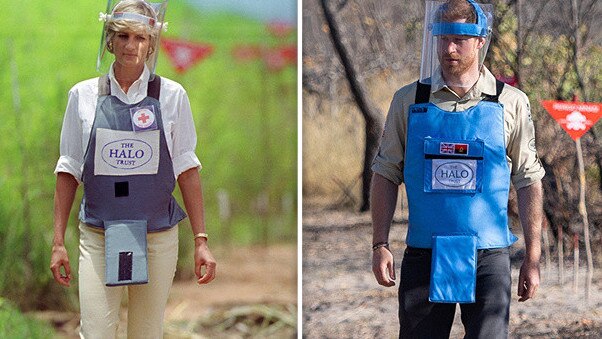
Royals
Don't miss out on the headlines from Royals. Followed categories will be added to My News.
Meghan, the Duchess of Sussex, has made a private visit to a memorial to a young South African woman whose rape and murder inspired thousands of people to protest the country’s high rate of sexual violence.
In the quiet visit, she tied a ribbon to the memorial at the post office where university student Uyinene Mrwetyana was attacked last month.
A post on the royals’ Instagram account calls the death “a critical point in the future of women’s rights in South Africa” and says the visit was “personally important” to Meghan.
The post says the duchess also has spoken with Mrwetyana’s mother. More than 100 rapes are reported every day in South Africa, and President Cyril Ramaphosa calls the country “one of the most unsafe places in the world to be a woman.”
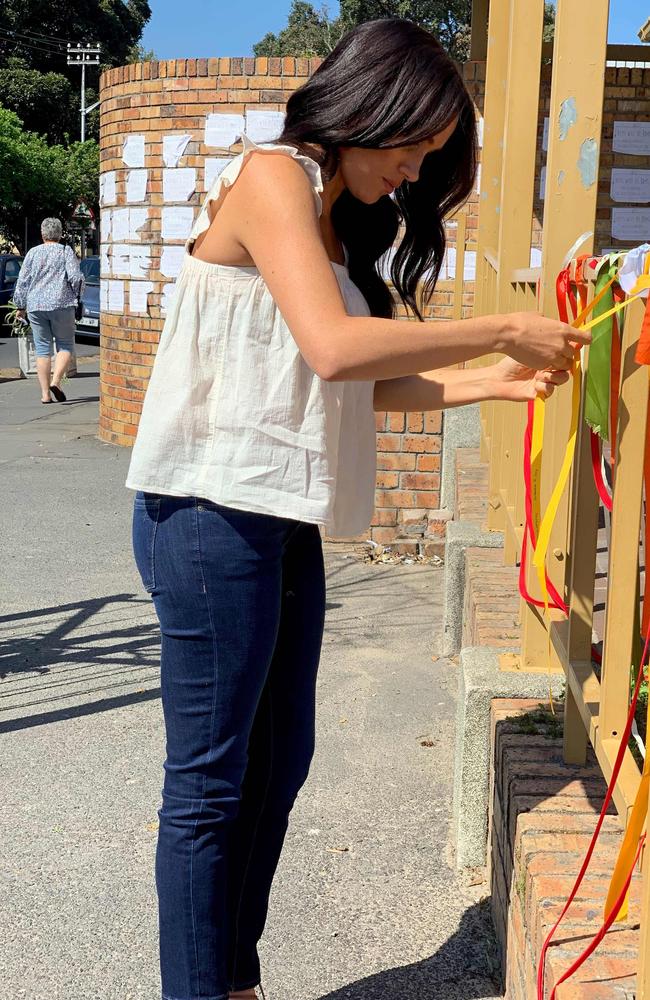
HARRY MEETS WITH ANGOLAN PRESIDENT
Prince Harry met with the Angolan president on Saturday as Meghan Markle and Baby Archie stay on in South Africa on the sixth day of the Royal tour.
Soldiers in uniform saluted the Duke of Sussex as he arrived on a red carpet to hold talks with Joao Lourenco at the presidential palace in Luanda.
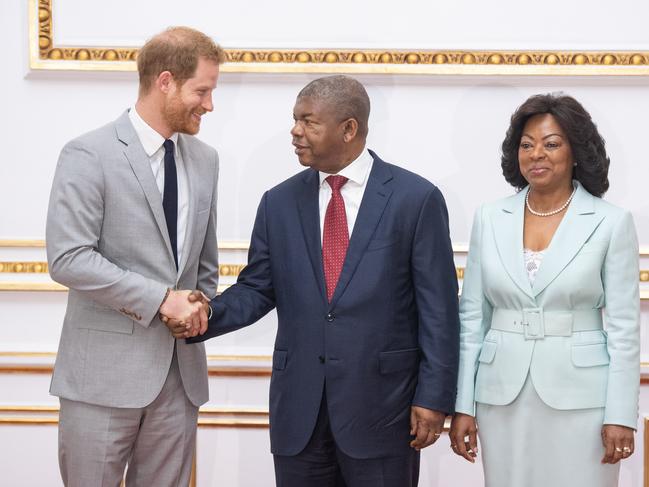
Harry will also visit a hospital to see the work of a project spearheaded by Angola’s first lady, Ana Dias Lourenco.
The project focuses on preventing the transmission of HIV/AIDS from mothers to their babies in a country where high fertility, a young population and lack of awareness are driving infection rates up.
On Sunday the prince will move on to Malawi, again for his first official visit, though he has visited the country several times privately in the past.
EMOTIONAL TRIP TO HUAMBO
It comes after Prince Harry has paid tribute to his mother the late Princess Diana in a “deeply personal” visit to Huambo, Angola, where he opened a clinic in her name and met with children injured by landmines.
On a day when he described landmines as “an unhealed scar of war”, the Duke of Sussex spoke candidly about the loss of his mother, and his desire to continue her campaigning work on the banning of landmines.
Harry visited the Princess Diana Orthopaedic Centre, which he named in her honour in front of Angolan government officials.
Just like his mother had done on her visit, Harry spoke warmly with children who were undergoing rehabilitation.
“This visit is obviously deeply personal and meaningful to me,” he said.
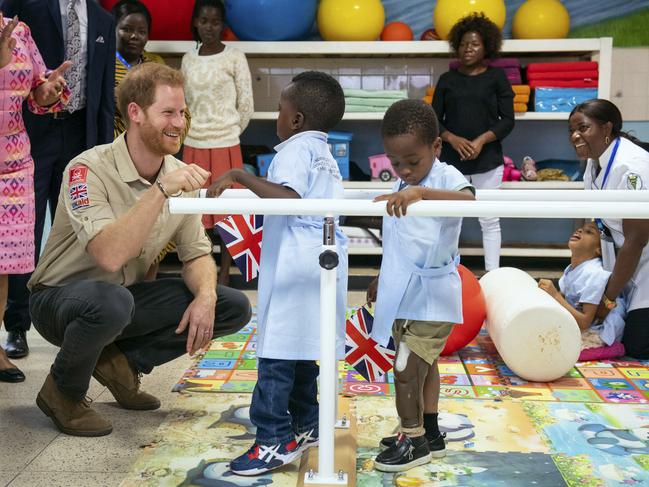
“Since my mother’s visit to Huambo many years ago, this city has undergone such a visible transformation.
“When she visited this centre during the conflict, it was full of men, women and even children injured by landmines.
“I know that if she were here today she would be delighted to see that this centre has grown into a global leader in orthopaedic rehabilitation.”
Princess Diana visited Huambo in 1997, just months before she was killed in a car crash in Paris.
It was on that trip that she walked through a live minefield, in a famous photograph that Harry recreated in Angola on Friday.
He also visited the site of the minefield, which has been rejuvenated into a street, with shops, schools and new homes.
The visit was part of Harry’s campaign to destroy all landmines by 2025.
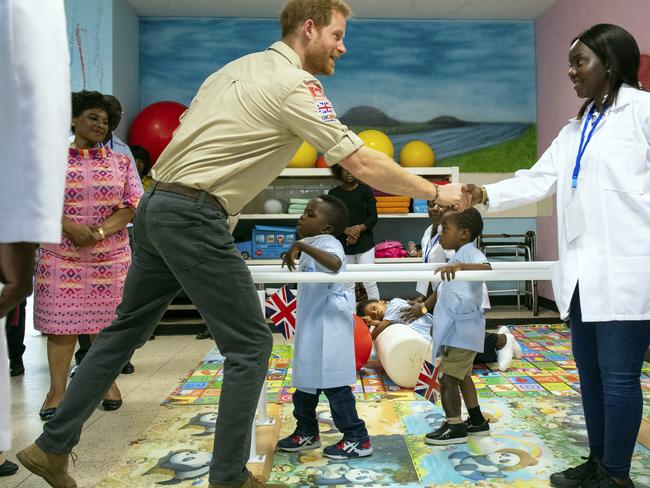
There are currently 60 million people living in 61 countries with the threat of landmines.
Charities including the HALO Trust and the Mines Advisory Group have spent more than 20 years clearing landmines in Angola.
Harry added: “It has been an honour to retrace my mother’s steps today. I lost her 22 years ago but the memory of her is with me daily and her legacy lives on, which is why I’m so happy to name this centre the Princess Diana Orthopaedic Centre.”
Huambo is seven hours drive from the Angolan capital of Luanda, which is on the coast.
It was once the centre of fighting in a bitter civil war, with rebels holding the town between 1992 and 1995.
Most of the buildings were destroyed, while some still bear the signs of war.
However, new hotels and new buildings have been developed following the removal of landmines, which were in some of the city’s main streets.
THE ‘AFRICAN PRINCE’
The late Princess Diana started the work, now her son Prince Harry is making sure it gets done.
Dubbed the “African prince”, Harry has walked through streets — filled with schools, shops and houses — which 22 years ago were nothing but a minefield, visited by the People’s Princess.
That photograph of Diana wearing a bulletproof vest and face visor, taken the year of her tragic death, prompted 122 countries to sign up to a treaty to ban landmines.
Sadly, more than two decades later there is still much more work to be done to protect women and children living with the aftermath of a bloody civil war in Angola.
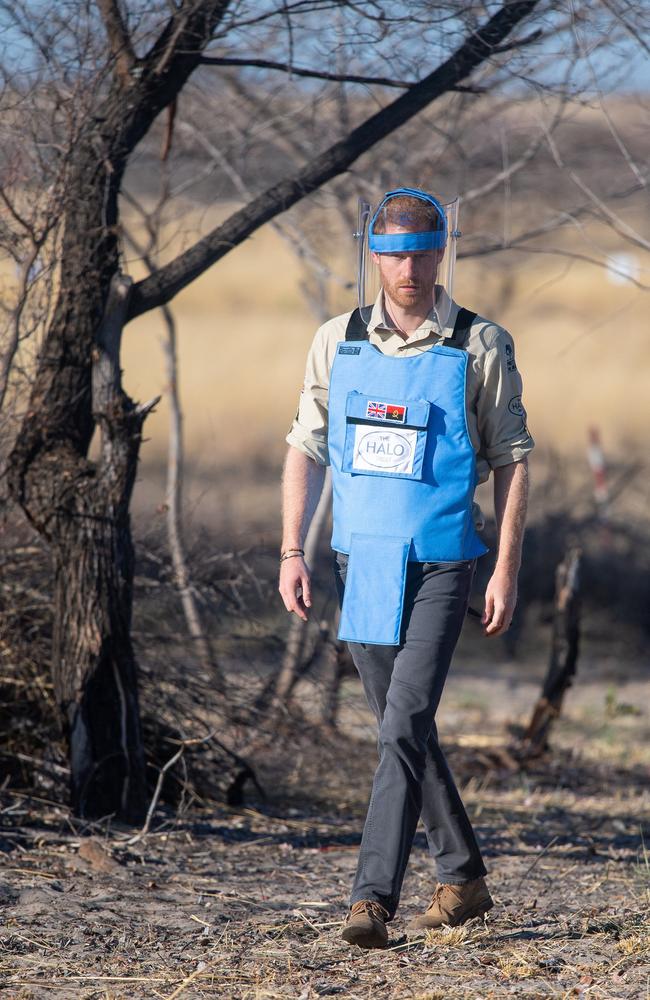
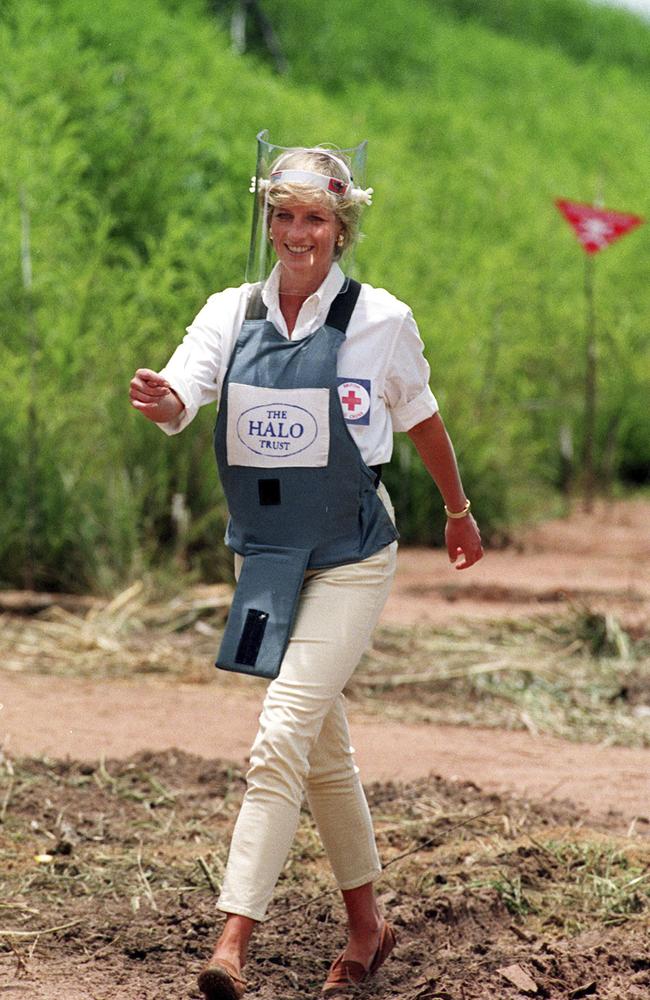
‘AN UNHEALED SCAR OF WAR’
Harry said landmines could be eradicated after deactivating a mine in Dirico, in the south east of Angola, and praised the Angolan Government’s $US60 million commitment.
“This historic commitment is a key step forward for the movement to rid the world of mines and lay the foundation for a safe and just future for the next generation,” Harry said.
“Landmines are an unhealed scar of war.
“By clearing the landmines, we can help this community find peace, and with peace comes opportunity.”
Harry said there was an added environmental benefit of clearing mines in the Luengue-Luiana National Park.
“Additionally, we can protect the diverse and unique wildlife that relies on the beautiful Cuito River that I slept beside last night. That river and those wildlife are your natural assets, and if looked after, will bring you unlimited opportunities within a conservation-led economy,” he said.
“It is fitting that this project starts in Dirico — at the convergence of the two rivers that flow from Angola’s highlands down to the Okavango Delta. These two rivers provide water and life to over a million people downstream and an essential and incredibly delicate habitat for an abundance of wildlife.”
“Just as these rivers extend for miles, so must this project extend far beyond Dirico.”
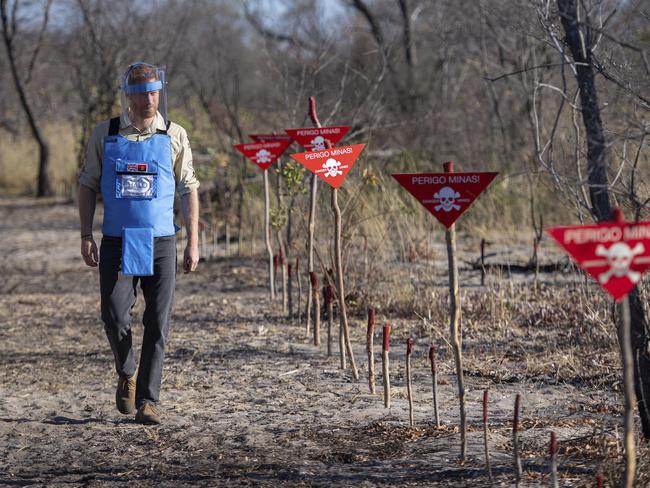
Louise Vaughan, a spokeswoman for the HALO Trust said more work was needed and encouraged continued aid support from the Australian Government.
The Australian Government has previously donated to clear landmines in Sri Lanka and Cambodia.
“After today every government will see how permanent and transformative humanitarian mine clearance is. We feel sure the world will get together to get the job done,” she said.
Another 42 countries have signed up to a treaty to ban landmines since Diana sparked international support for the deal in 1997 bringing the total to 164 territories.
Landmines remain in 61 countries globally, and are affect 60 million people, with an campaign to eradicate landmines by 2025 costing $US100 million per year.
The area where Diana walked is now a paved road, wide enough to fit three cars. A new secondary school has also been built and there are houses with satellite dishes and shops.
The street is near the centre of Huambo, seven hours drive from the capital Luanda. A tree where Diana was photographed is all that remains of the minefield.
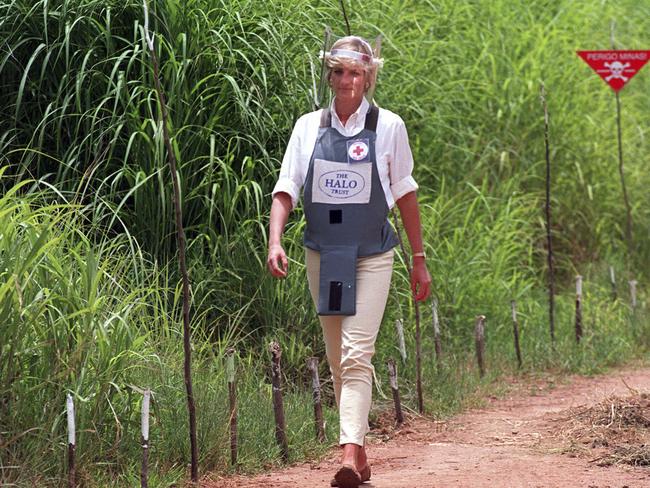
HARRY’S JOURNEY FOLLOWS DIANA
The minefield where Diana walked is now a vastly different place. A British MP had called Diana a “loose cannon” ahead of her trip to Angola. When asked at the time about the criticism, Diana replied: “I’m only trying to highlight a problem that’s going on all around the world, that’s all.”
During her visit to Huambo, the crew found a mine and asked her to remotely detonate the killer weapon. “One down, 17 million to go,” Diana said, as she pushed the button.
There was also a direct connection between Diana’s iconic walk and Harry’s visit. The Governor of Huambo, Joana Lina, was also the official host for the late Princess Diana’s visit. Harry’s efforts to continue his mother’s work was not confined to these events.
He has been patron of the HALO Trust, which organised his mother’s visit to Angola since 2013.
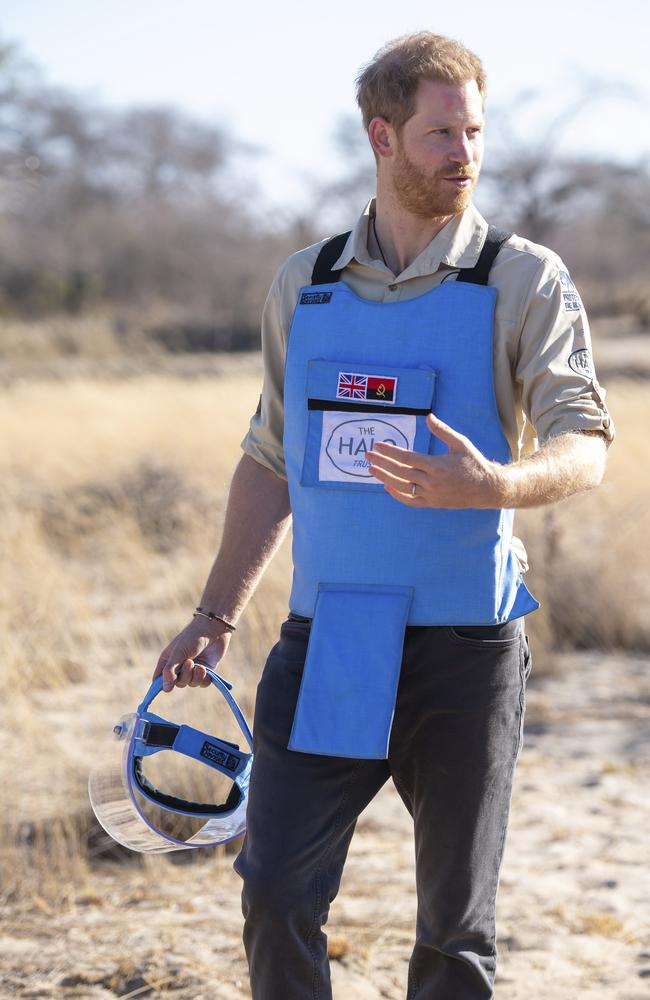
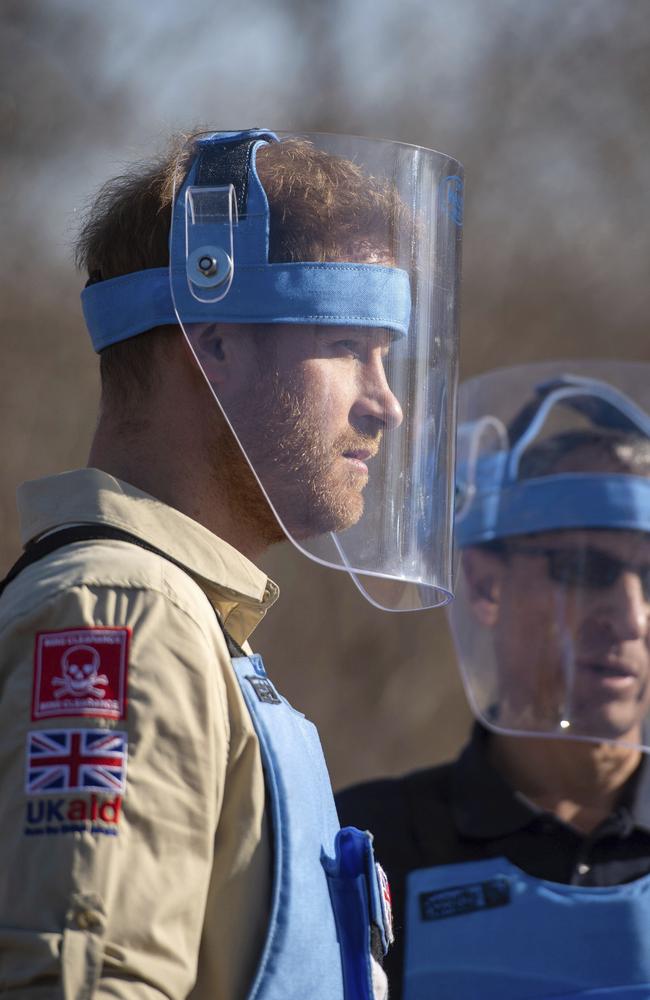
Harry made a poignant speech in 2017, the 20th anniversary of his mother’s visit to Huambo, where he said no-one could rest until all landmines were gone.
“At the time, the attention my mother brought to this issue wasn’t universally popular; some believed she had stepped over the line into the arena of political campaigning — but for her this wasn’t about politics; it was about people,” he said.
“My mother had been shocked and appalled by the impact that landmines were having on incredibly vulnerable people and on children in particular.
“She did not understand why more people were not willing to address the cause of so much suffering.
“She refused to accept that these destructive weapons should be left where they were, just because they were perceived as too expensive and difficult to remove.”
The Angolan government has been a supporter of Harry’s charity and allocated $60 million to eradicate landmines.
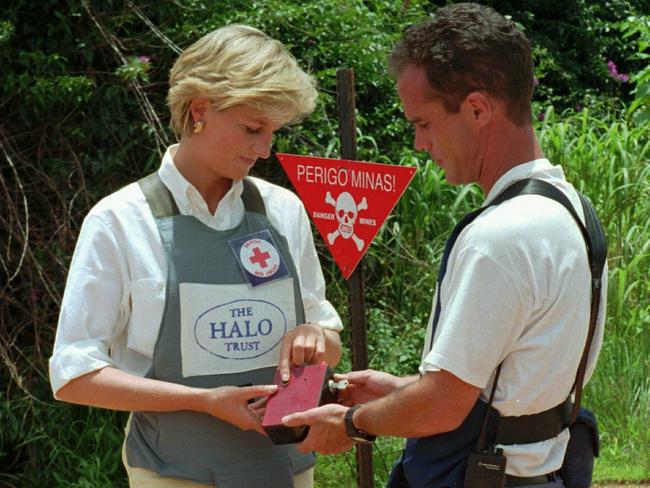

Harry has pointed out that it would only take £100 million per year ($A180 million) to get rid of landmines by 2025, saying it was equivalent to one star signing in the Premier League football.
Valdemar Fernandes, an operations manager for the mine clearing charity The Halo Trust, was clearing mines in 1997 when Diana visited and he met Harry last night in Huambo.
He had joined HALO as a deminer just a few weeks before Diana’s visit.
He showed Harry the work that was done since the historic visit, including before and after satellite images.
The father of three lived in Huambo throughout the civil war.
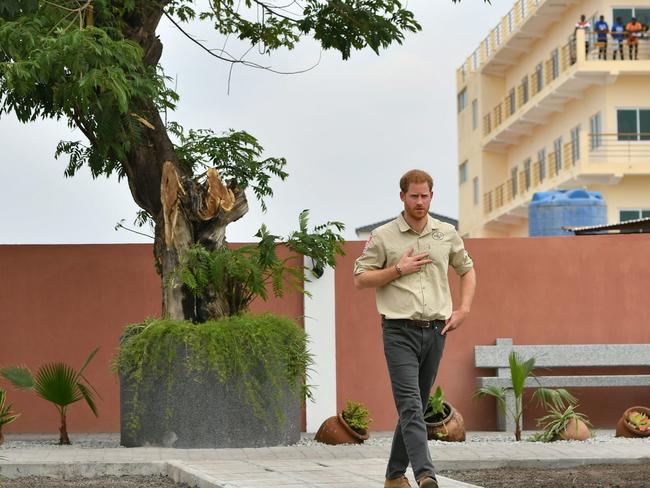
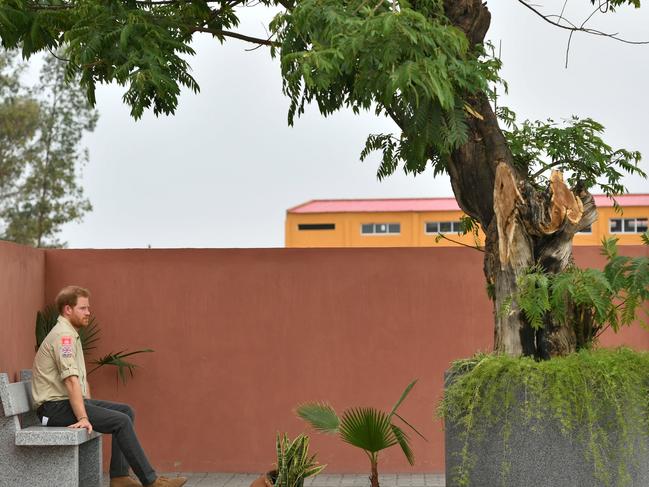
“It was an enormous privilege to meet Prince Harry in the very area where I myself have cleared many landmines from the ground,” Mr Fernandes, 45, said.
“By coming here today he has shown the world the difference mine clearance makes.
“It was a great honour to retrace his mother’s footsteps alongside him and I will remember it for the rest of my life.”
Buckingham Palace said Prince Harry would make a trip to the Huambo Orthopaedic Centre, also visited by his mother in 1997. Recently renovated, it aims to become Angola’s national centre of excellence in orthopaedic care.
“His Royal Highness will be greeted by the Minister for Health, the Director of the Orthopaedic Centre, and a representative of BP, which has donated equipment to the centre.
“The centre’s new name, in honour of Princess Diana, will be unveiled by His Royal Highness, after which he will tour the facilities and make a short speech before departing for Luanda.”
Jeanette Dijkstra, director of MAG’s Angola program, said more than 70 per cent of Angola’s minefields had been cleared since Diana’s visit.
“This huge impact would not have been possible without the generosity of nearly 50 governments, companies, institutes and also the public, with a special thanks to the US, Japanese, UK and EU governments,” she said.
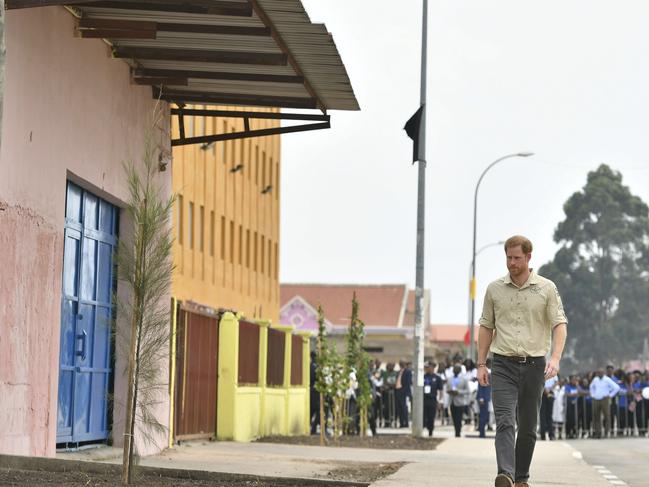
“They have saved countless lives and returned land stolen by war. These communities are now flourishing. Farms, houses, schools and hospitals occupy land that would once have killed.
“But there are still over 1200 known and suspected minefields to clear here.
“The world needs to do more, faster, to ensure countries like Angola can be completely free of the landmines and unexploded bombs that have hindered and hurt people here for so long.”
Royal expert Dickie Arbiter, who was a spokesman for the Queen, said Harry was visiting Angola in his own right, not in his mother’s shadow.
“I think people should stop comparing,” he said.
“Harry has just picked up where she left off.”
stephen.drill@news.co.uk
